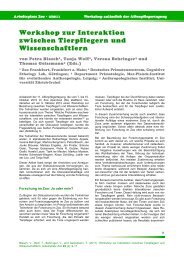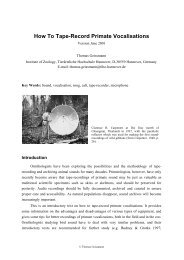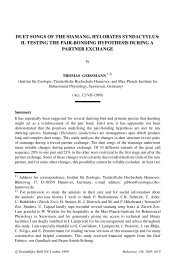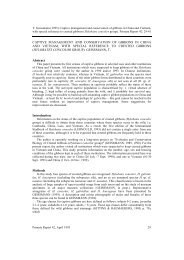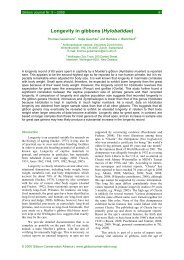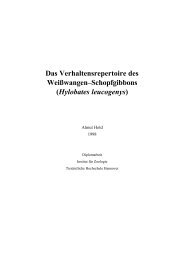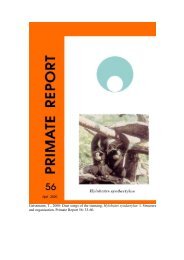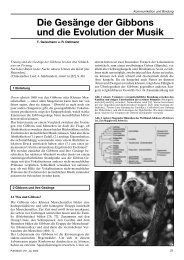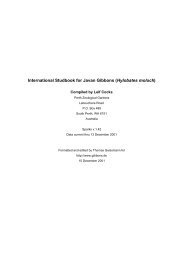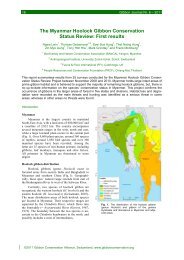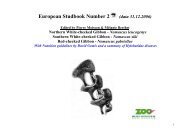22 T. Geissmann et al. – <strong>The</strong> Male Song <strong>of</strong> <strong>the</strong> <strong>Javan</strong> Silvery Gibbon<strong>the</strong> results would help to narrow down <strong>the</strong>possible functions <strong>of</strong> singing in <strong>male</strong> <strong>gibbon</strong>s. If,for instance, <strong>the</strong> extremely variable <strong>song</strong>s <strong>of</strong> <strong>the</strong><strong>male</strong> <strong>silvery</strong> <strong>gibbon</strong> were found to be more costintensivethan <strong>the</strong> more stereotyped <strong>song</strong>s <strong>of</strong> o<strong>the</strong>r<strong>gibbon</strong> species, this could explain why <strong>silvery</strong><strong>gibbon</strong>s sing less <strong>of</strong>ten and why <strong>the</strong>ir rare <strong>song</strong>scan still serve to advertise fitness. If <strong>the</strong> morestereotyped <strong>song</strong>s <strong>of</strong> <strong>male</strong> Kloss’s <strong>gibbon</strong>s arecheaper to produce, this would explain why <strong>the</strong>yhave to be produced more <strong>of</strong>ten in order to beenough <strong>of</strong> a handicap.It has previously been suggested that <strong>gibbon</strong><strong>song</strong>s – even within one species – serve more thanone function (Geissmann, 1999; Geissmann andOrgeldinger, 2000). Results <strong>of</strong> <strong>the</strong> present studyreveal a differential <strong>song</strong> variability occurringamong <strong>the</strong> various <strong>gibbon</strong> species. This fur<strong>the</strong>rsupports <strong>the</strong> view that <strong>gibbon</strong> <strong>song</strong>s aremultifunctional and that <strong>the</strong> relevance <strong>of</strong> <strong>the</strong>sefunctions exhibits strong differences among <strong>the</strong>species. Expecting to discover “<strong>the</strong> <strong>song</strong> function”<strong>of</strong> “<strong>the</strong> <strong>gibbon</strong>” does not appear to be a realisticanymore.Conclusions1 <strong>The</strong> note repertoire <strong>of</strong> <strong>silvery</strong> <strong>gibbon</strong> <strong>male</strong>sappears to exhibit a higher degree <strong>of</strong> interindividualvariability than o<strong>the</strong>r <strong>gibbon</strong>s.2 <strong>The</strong> note repertoire <strong>of</strong> <strong>silvery</strong> <strong>gibbon</strong> <strong>male</strong>sappears to exhibit a higher degree <strong>of</strong> intraindividualvariability than o<strong>the</strong>r <strong>gibbon</strong>s (both<strong>male</strong>s and fe<strong>male</strong>s).3 <strong>The</strong> high variability <strong>of</strong> <strong>the</strong> <strong>male</strong> <strong>song</strong> in <strong>the</strong><strong>silvery</strong> <strong>gibbon</strong> appears to be a derivedcharacteristic among <strong>the</strong> Hylobatidae.4 Male <strong>song</strong>s <strong>of</strong> H. <strong>moloch</strong> may function more toadvertise individual fitness than ownership <strong>of</strong>resources.5 Specific experiments are required in order todetermine whe<strong>the</strong>r different costs are involvedwith producing variable versus stereotyped<strong>song</strong>s.6 Gibbon <strong>song</strong>s probably serve multiple functionsand <strong>the</strong>se functions or <strong>the</strong>ir relevance differamong <strong>gibbon</strong> species.AcknowledgementsAdditional tape-recordings used in <strong>the</strong> present study werekindly made available by Dr. Markus Kappeler and Dr. BjörnMerker. We are grateful to Dr. Robert Dallmann and twoanonymous reviewers for reading and commenting on thismanuscript.ReferencesBrockelman WY, Srikosamatara S. 1984. Maintenance andevolution <strong>of</strong> social structure in <strong>gibbon</strong>s. In: Preusch<strong>of</strong>t H,Chivers DJ, Brockelman WY, Creel N, eds. <strong>The</strong> lesserapes. Evolutionary and behavioural biology. Edinburgh:Edinburgh University Press, 298-323.Charif RA, Mitchell S, Clark CW. 1995. Canary 1.2 user’smanual. New York: Cornell Laboratory <strong>of</strong> Ornithology,Ithaca.Chivers DJ. 1977. <strong>The</strong> lesser apes. In: Prince Rainier III <strong>of</strong>Monaco, Bourne GH, eds. Primate conservation. NewYork: Academic Press, 539-598.Chivers DJ. 2001. <strong>The</strong> swinging singing apes: Fighting forfood and family in far-east forests. In Chicago ZoologicalSociety, ed. <strong>The</strong> apes: Challenges for <strong>the</strong> 21st century.Brookfield Zoo, May 10-13, 2000, ConferenceProceedings. Brookfield, Illinois, U.S.A.: ChicagoZoological Society, 1-28.Cowlishaw G. 1992. Song function in <strong>gibbon</strong>s. Behaviour121: 131-153.Cowlishaw G. 1996. Sexual selection and informationcontent in <strong>gibbon</strong> <strong>song</strong> bouts. Ethology 102: 272-284.Clutton-Brock TH, Harvey PH. 1977. Primate ecology andsocial organization. J. Zool. 183: 1-39.Dallmann R, Geissmann T. 2001a. Different levels <strong>of</strong>variability in <strong>the</strong> fe<strong>male</strong> <strong>song</strong> <strong>of</strong> wild <strong>silvery</strong> <strong>gibbon</strong>s(<strong>Hylobates</strong> <strong>moloch</strong>). Behaviour 138: 629-648.Dallmann R, Geissmann T. 2001b. Individuality in <strong>the</strong>fe<strong>male</strong> <strong>song</strong>s <strong>of</strong> wild <strong>silvery</strong> <strong>gibbon</strong>s (<strong>Hylobates</strong> <strong>moloch</strong>)on Java, Indonesia. Contrib. Zool. 70: 41-50.Demars C, Goustard M. 1978. Le “grand chant”d’<strong>Hylobates</strong> concolor leucogenys. Comparaison avec lesémissions sonores homologues d’H. concolor gabriellae etd’H. klossii (Îles Mentawei, ouest Sumatra). Behaviour65: 1-26 (French text, English summary).Fitch WT, Neubauer J, Herzel H. 2002. Calls out <strong>of</strong> chaos:<strong>The</strong> adaptive significance <strong>of</strong> nonlinear phenomena inmammalian vocal production. Anim. Behav. 63: 407-418.Geissmann T. 1993. Evolution <strong>of</strong> communication in <strong>gibbon</strong>s(Hylobatidae). PhD <strong>the</strong>sis, Anthropological Institute,Philosoph. Faculty II, Zürich University, 374 pp.Geissmann T. 1995. Gibbon systematics and speciesidentification. Int. Zoo News 42: 467-501.Geissmann T. 1999. Duet <strong>song</strong>s <strong>of</strong> <strong>the</strong> siamang, <strong>Hylobates</strong>syndactylus: II. Testing <strong>the</strong> pair-bonding hypo<strong>the</strong>sisduring a partner exchange. Behaviour 136: 1005-1039.Geissmann T. 2000. Gibbon <strong>song</strong>s and human music from anevolutionary perspective. In: Wallin NL, Merker B, BrownS, eds. <strong>The</strong> origins <strong>of</strong> music. Cambridge, Massachusetts:MIT Press, 103-123.
Contributions to Zoology, 74 (1/2) – 2005 23Geissmann T. 2002a. Duet-splitting and <strong>the</strong> evolution <strong>of</strong><strong>gibbon</strong> <strong>song</strong>s. Biol. Rev. 77: 57-76.Geissmann T. 2002b. Taxonomy and evolution <strong>of</strong> <strong>gibbon</strong>s.In: Soligo C, Anzenberger G, Martin RD. eds.Anthropology and primatology into <strong>the</strong> third millennium:<strong>The</strong> Centenary Congress <strong>of</strong> <strong>the</strong> Zürich AnthropologicalInstitute (Evolutionary Anthropology Vol. 11, Supplement1) (pp. 28-31). New York: Wiley-Liss.Geissmann T, Dallmann R. 2002. Die Gesänge der Gibbonsund die Evolution der Musik. Praxis derNaturwissenschaften – Biologie in der Schule 51(1): 21-29(German text).Geissmann T, Nijman V. 2001. Calling behaviour <strong>of</strong> wild<strong>Javan</strong> <strong>gibbon</strong>s <strong>Hylobates</strong> <strong>moloch</strong> in Java, Indonesia. In:Nijman, V, ed. Forest (and) primates: Conservation andecology <strong>of</strong> <strong>the</strong> endemic primates <strong>of</strong> Java and Borneo.Tropenbos-Kalimantan Series Vol. 5. Wageningen, <strong>The</strong>Ne<strong>the</strong>rlands: Tropenbos International, pp. 43-59.Geissmann T, Orgeldinger M. 2000. <strong>The</strong> relationshipbetween duet <strong>song</strong>s and pair bonds in siamangs, <strong>Hylobates</strong>syndactylus. Anim. Behav. 60: 805-809.Gittins SP, Raemaekers JJ. 1980. Siamang, lar and agile<strong>gibbon</strong>s. In: Chivers DJ, ed. Malayan forest primates –Ten years’ study in tropical rain forest. New York:Plenum Press, pp. 63-105.Goustard M. 1976. <strong>The</strong> vocalizations <strong>of</strong> <strong>Hylobates</strong>. In:Rumbaugh DM, ed. Gibbon and siamang, vol. 4. Baseland New York: Karger, pp. 135-166.Haim<strong>of</strong>f EH. 1983. Gibbon <strong>song</strong>s: An acoustical,organizational, and behavioural analysis. PhD <strong>the</strong>sis,University <strong>of</strong> Cambridge, pp. xxiii+412 pp.Haim<strong>of</strong>f EH. 1984a. Acoustic and organizational features <strong>of</strong><strong>gibbon</strong> <strong>song</strong>s. In: Preusch<strong>of</strong>t H, Chivers DJ, BrockelmanWY, Creel N, eds. <strong>The</strong> lesser apes. Evolutionary andbehavioural biology. Edinburgh: Edinburgh UniversityPress, pp. 333-353.Haim<strong>of</strong>f EH. 1984b. <strong>The</strong> organization <strong>of</strong> <strong>song</strong> in <strong>the</strong> agile<strong>gibbon</strong> (<strong>Hylobates</strong> agilis). Folia Primatol. 42: 42-61.Haim<strong>of</strong>f EH. 1985. <strong>The</strong> organization <strong>of</strong> <strong>song</strong> in Müller’s<strong>gibbon</strong> (<strong>Hylobates</strong> muelleri). Int. J. Primatol. 6: 173-192.Haim<strong>of</strong>f EH, Tilson RL. 1985. Individuality in <strong>the</strong> fe<strong>male</strong><strong>song</strong>s <strong>of</strong> wild Kloss’ <strong>gibbon</strong>s (<strong>Hylobates</strong> klossii) onSiberut Island, Indonesia. Folia Primatol. 44: 129-137.Haim<strong>of</strong>f EH, Gittins SP. 1985. Individuality in <strong>the</strong> <strong>song</strong>s <strong>of</strong>wild agile <strong>gibbon</strong>s (<strong>Hylobates</strong> agilis) <strong>of</strong> PeninsularMalaysia. Am. J. Primatol. 8: 239 - 247.Kappeler M. 1981. <strong>The</strong> <strong>Javan</strong> <strong>silvery</strong> <strong>gibbon</strong> (<strong>Hylobates</strong> lar<strong>moloch</strong>). PhD <strong>the</strong>sis, Philisophisch-Naturwissenschaftliche Fakultät, Universität Basel.Kappeler M. 1984a. Vocal bouts and territorial maintenancein <strong>the</strong> <strong>moloch</strong> <strong>gibbon</strong>. In: Preusch<strong>of</strong>t H, Chivers DJ,Brockelman WY, Creel N, eds. <strong>The</strong> lesser apes.Evolutionary and behavioural biology. Edinburgh:Edinburgh University Press, 376-389.Kappeler M. 1984b. <strong>The</strong> <strong>gibbon</strong> in Java. In: Preusch<strong>of</strong>t H,Chivers DJ, Brockelman WY, Creel N, eds. <strong>The</strong> lesserapes. Evolutionary and behavioural biology. Edinburgh:Edinburgh University Press, 19-31.Leighton DR. 1987. Gibbons: Territoriality and monogamy.In: Smuts BB, Cheney DL, Seyfarth RM, Wrangham RW,Struhsaker TT, eds. Primate societies. Chicago andLondon: University <strong>of</strong> Chicago Press, 135-145.Marshall JT, Marshall ER. 1976. Gibbons and <strong>the</strong>irterritorial <strong>song</strong>s. Science 193: 235-237.Marshall JT, Sugardjito J. 1986. Gibbon systematics. In:Swindler DR, Erwin J, eds. Comparative primate biology,vol. 1: Systematics, evolution, and anatomy. New York:Alan R. Liss, 137-185.Mitani JC. 1985. Responses <strong>of</strong> <strong>gibbon</strong>s (<strong>Hylobates</strong> muelleri)to self, neighbor, and stranger <strong>song</strong> duets. Int. J. Primatol.6: 193-200.Mitani JC. 1988. Male <strong>gibbon</strong> (<strong>Hylobates</strong> agilis) singingbehavior: Natural history, <strong>song</strong> variations and function.Ethology 79: 177-194.Mitani JC. 1992. Singing behavior <strong>of</strong> <strong>male</strong> <strong>gibbon</strong>s: Fieldobservations and experiments. In: Nishida T, McGrewWC, Marler P, Pickford M, deWaal FBM, eds. Topics inprimatology, vol. 1: Human origins. Tokyo: University <strong>of</strong>Tokyo Press, 199-210.Mitani JC, Marler P. 1989. A phonological analysis <strong>of</strong> <strong>male</strong><strong>gibbon</strong> singing behavior. Behaviour 109: 20-45.Mitani JC, Gros-Louis J, Macedonia JM. 1996. Selectionfor acoustic individuality within <strong>the</strong> vocal repertoire <strong>of</strong>wild chimpanzees. Int. J. Primatol. 17: 569-583.Raemaekers JJ, Raemaekers PM, Haim<strong>of</strong>f EH. 1984.Loud calls <strong>of</strong> <strong>the</strong> <strong>gibbon</strong> (<strong>Hylobates</strong> lar): Repertoire,organization and context. Behaviour 91: 146-189.Roos C, Geissmann T. 2001. Molecular phylogeny <strong>of</strong> <strong>the</strong>major hylobatid divisions. Molec. Phylogen. Evol. 19:486-494.Snowdon CT. 1986. Vocal communication. In: Mitchell DR,Erwin J, eds. Comparative primate biology, vol. 2A:Behavior, conservation, and ecology. New York: Alan R.Liss, 495-530.Tenaza RR. 1976. Songs, choruses and countersingingamong Kloss’ <strong>gibbon</strong>s (<strong>Hylobates</strong> klossi) in Siberut island,Indonesia. Z. Tierpsychol. 40: 37-52.Waser PM. 1982. <strong>The</strong> evolution <strong>of</strong> <strong>male</strong> loud calls amongmangabeys and baboons. In: Snowdon CT, Brown CH,Petersen MR, eds. Primate communication. Cambridge:Cambridge University Press, 117-143.Whitten AJ. 1980. <strong>The</strong> Kloss <strong>gibbon</strong> in Siberut rain forest.Ph.D. <strong>the</strong>sis, Sub-Department <strong>of</strong> Veterinary Anatomy,University <strong>of</strong> Cambridge.Whitten T. 1982. <strong>The</strong> ecology <strong>of</strong> singing in Kloss <strong>gibbon</strong>s(<strong>Hylobates</strong> klossii) on Siberut Island, Indonesia. Int. J.Primatol. 3: 33-51.Whitten T. 1984a. Defense by singing. Great calls and <strong>song</strong>s<strong>of</strong> <strong>the</strong> Kloss <strong>gibbon</strong>. In: MacDonald D, ed. <strong>The</strong>encyclopedia <strong>of</strong> mammals, vol. 1. London: Allen andUnwin, 420-421.Whitten AJ. 1984b. <strong>The</strong> trilling handicap in Kloss <strong>gibbon</strong>s.In: Preusch<strong>of</strong>t H, Chivers DJ, Brockelman WY, Creel N,eds. <strong>The</strong> lesser apes. Evolutionary and behaviouralbiology. Edinburgh: Edinburgh University Press, 416-419.Zahavi A. 1975. Mate selection – a selection for a handicap.J. <strong>The</strong>oret. Biol. 53: 205-214.Zahavi A, Zahavi A. 1997. <strong>The</strong> handicap principle: Amissing piece <strong>of</strong> Darwin’s puzzle. New York and Oxford:Oxford University Press.Received: 28 March 2003Accepted: 16 September 2004



